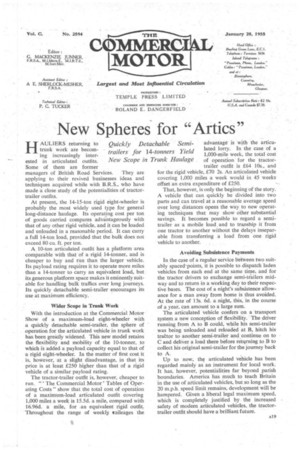New Spheres for "Artics"
Page 21

If you've noticed an error in this article please click here to report it so we can fix it.
Quickly Detachable Semitrailers for 14-tonners Yield New Scope in Trunk Haulage HAUL1ERS returning to trunk work are becoming increasingly interested in articulated outfits. Some of them are former managers of British Road Services. They are applying to their revived businesses ideas and techniques acquired while with B.R.S., who have made a close study of the potentialities of tractortrailer outfits.
At present, the 14-15-ton rigid eight-wheeler is probably the most widely used type for general long-distance haulage. Its operating cost per ton of goods carried compares advantageously with that of any other rigid vehicle, and it can be loaded and unloaded in a reasonable period. It can carry a full 14-ton load, provided that the bulk does not exceed 80 cu. ft. per ton.
A 10-ton articulated outfit has a platform area comparable with that of a rigid 14-tonner, and is cheaper to buy and run than the larger vehicle. Its payload rating requires it to operate more miles than a 14-tonner to carry an equivalent load, but its generous platform space makes it eminently suitable for handling bulk traffics over long journeys. Its quickly detachable semi-trailer encourages its use at maximum efficiency.
Wider Scope in Trunk Work With the introduction at the Commercial Motor Show of a maximum-load eight-wheeler with a quickly detachable semi-trailer, the sphere of operation for the articulated vehicle in trunk work has been greatly widened. This new model retains the flexibility and mobility of the 10-tonner, to which is added a payload capacity equal to that of a rigid eight-wheeler. In the matter of first cost it is, however, at a slight disadvantage, in that its price is at beast £250 higher than that of a rigid vehicle of a similar payload rating.
The tractor-trailer outfit is, however, cheaper to run. "'The Commercial Motor' Tables of Operating Costs" show that the total cost of operation of a maximum-load articulated outfit covering 1,000 miles a week is 15.5d. a mile, compared with 16.96d. a mile, for an equivalent rigid outfit. Throughout the range of weekly Inileages the advantage is with the articulated lorry. In the case of a 1,000-mile week, the total cost of operation for the tractortrailer outfit is £64 10s., and for the rigid vehicle, £70 2s. An articulated vehicle covering 1,000 miles a week would in 45 weeks offset an extra expenditure of £250.
That, however, is only the beginning of the story. A vehicle that can quickly be divided into two parts and can travel at a reasonable average speed over long distances opens the way to new operating techniques that may show other substantial savings. It becomes possible to regard a semitrailer as a mobile load, and to tranship it from one tractor to another without the delays inseparable from transferring a load from one rigid vehicle to another.
Avoiding Subsistence Payments In the case of a regular service between two suitably spaced-points, it is possible to dispatch laden vehicles from each end at the same time, and for the tractor drivers to exchange semi-trailers midway and to return in a working day to their respective bases. The cost of a night's subsistence allowance for a man away from home is thus avoided. At the rate of 13s. 6d. a night, this, in the course of a year, can amount to a large sum.
The articulated vehicle confers on a transport system a new conception of flexibility. The driver running from A to B could, while his semi-trailer was being unloaded and reloaded at B, hitch his trattor to another semi-trailer and continue on to C and deliver a load there before returning to B to collect his original semi-trailer for the journey back to A.
Up to now, the articulated vehicle has been regarded mainly as an instrument for local work. It has, however, potentialities far beyond parish boundaries. America has much to teach Britain in the use of articulated vehicles, but so long as the 20 m.p.h. speed limit remains, development will be hampered. Given a liberal legal maximum speed, which is completely justified by the increased safety of modern articulated vehicles, the tractortrailer outfit should have a brilliant future.




















































































